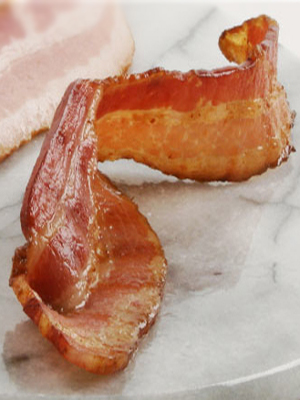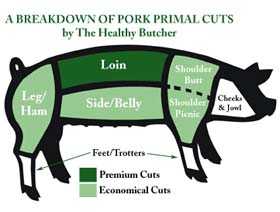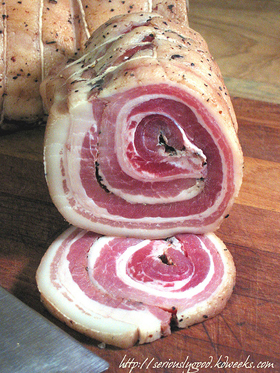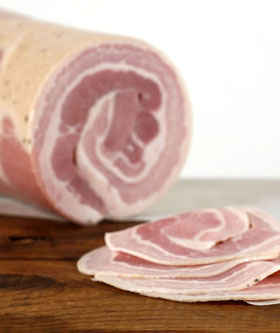 |
| |
|

Crisp and fragrant, what we consider to be bacon—streaky bacon from the belly of the pig—began to evolve in the 1700s. Photo courtesy iGourmet.com.
|
| WHAT IT IS: Skillet Bacon Spread: a spread made from premium cooked bacon. |
| WHY IT’S DIFFERENT: It’s the first commercial bacon spread we’ve come across (our own bacon jam recipe is on Page 3). |
|
WHY WE LOVE IT: Woo hoo: another way to enjoy bacon!
|
| WHERE TO BUY IT: Online. |
|
|
 |
Bacon History: Bringing
Home The Bacon In 9,000 B.C.E.
Jump to the article index below
The History Of Bacon
How about a shout-out to those ancient Middle Easterners who domesticated* the wild boar as early as 9,000 B.C.E., in the Tigris River basin. (The boar was domesticated independently in Asia.)
To these brave and hungry hunters and boar-wranglers we owe ham and bacon—although the modern bacon we know and love wouldn’t appear until the mid-1700s.†
While boar and pig meat was cured from earliest times (smoked, salted and/or dried), it was in the early- to-mid 18th century in which a transformation began that distinguished “bacon” as the side of pork (the pig’s sides), cured with salt. Numerous food historians credit pig farmers in the English countryside for noticing that some breeds of pig had meatier sides.

Bacon comes from the side or belly of the pig. Chart courtesy TheHealthyButcher.com.
*Because pigs will not be herded like goats and sheep, they were part of domestic settlements rather than nomadic peoples.
†The word “bacon” originally referred to all pork. It derived from the Old High German “bacho,” meaning “buttock”—the part we call ham or leg of pork. When the word evolved into the 14th century Old French “bacun,” it referred to all back meat. The 16th century Middle English word “bacoun” referred to all cured pork, not just the back meat. “Canadian bacon” (also know as back bacon and Irish bacon) is a very lean and ham-like cut from the loin. In the U.S., bacon comes from the fattier pork belly (and is known as streaky bacon in the U.K., describing the streak of meat in the strips of fat).
The article continues below, along with the different types of bacon.
|
| |
|
|
|
INDEX OF REVIEW
This is Page 3 of a four-page article. Click on the black links to visit other pages:
|
MORE TO DISCOVER
More Bacon Recipes
|
Bacon History, Continued
The British system for making bacon became widespread in the 18th century, and spread to other parts of Europe.
By the 1700s in England, bacon was defined as meat cut from the side of the pig and cured with salt. If you come across the word gammon in books or films from the U.K., it refers to the entire side of bacon. A rasher is a thin slice of bacon or ham for frying or broiling or a portion of three or four slices.
According to The Oxford Companion To Food, the first large-scale bacon curing business was established in the 1770s in the county of Wiltshire, in south-central England, by one John Harris.
According to some accounts of the history of bacon, John Harris of Wiltshire set up one of the first bacon curing shops in the country. The place has certainly become known for its production of bacon.
|
|

Guanciale is bacon made from the cheeks (jowls) of the pig, and then rolled. Photo courtesy SeriouslyGood.KDWeeks.com. |
In the late 18th and early 19th centuries, Asian pigs were introduced to Europe and crossbred to create breeds with qualities that made them better as bacon pigs, lard pigs, ham pigs and so forth. Today there are more than 70 breeds in commercial production. Take a look at them here.
FOOD TRIVIA: The phrase “bringing home the bacon” purportedly originated in the twelfth century, when a church in the English town of Dunmow, an ancient market town in the southeast England county of Essex, offered a side of bacon to any married man who could swear before the congregation and God that he had not quarreled with his wife for a year and a day.
You can interpret this as a sexist contest, since wives were deemed to be so quarrelsome that only a man with the patience of a saint (or a deaf ear) could hope to win the challenge.
Types Of Bacon
Different types of bacon are cut from different parts of the pig. While they have in common the salting and curing of the meat, the appearances, textures and flavors vary. Bacon can be cut into strips or rolled (to be cut during preparation).
- Back Bacon, Canadian Bacon or Irish Bacon. This cut comes from the loin in the middle of the back of the pig. It is a very lean, meaty cut of bacon with a ham-like texture. However, unlike Canadian bacon, Irish bacon has a layer of fat around the meat to enhance the flavor. The loin of the pig comprises its back, hence the term back bacon.
- Bacon. A cut of pork that is salted, cured, and generally served with breakfast foods or on hamburgers and sandwiches. In the U.S., more than 70% of bacon is consumed at breakfast.
- Cottage Bacon. A meaty, lean pork meat from the pig’s shoulder. It is typically cut into thin, oval slices. It is cured and then sliced into round pieces for baking or frying.
- Gammon. The British term for a side of bacon.
- Jowl Bacon or Guanciale. This meat, from the cheeks of the pig, is smoked and sliced or rolled.
- Middle Bacon. Cut from the side of the animal, middle bacon is between side bacon and back bacon in cost, fat content and flavor.
- Pancetta. Pancetta is Italian back bacon, available smoked or unsmoked. It is typically salt cured and seasoned with spices (fennel, garlic, nutmeg, peppercorns, even hot chile flakes) and then dried. It can be sold in straight strips or in rolls.
-
Pork Belly, Side or Side Pork. This is the area on the lower side and underside of the pig from which American bacon (“side bacon” or “streaky bacon”) is cut (see chart above). Though a fattier meat, it can be diced for stir-fry, rolled for roasting or cut into square or rectangular “steaks”—a preparation that has become popular at chic restaurants in the last five years.
- Rasher. A slice (or a portion of three to four slices) of bacon.
|
|

Pancetta, Italian bacon. Photo courtesy DeLallo.com.
|
- Salt Pork or Side Pork. Bacon from the belly that is more fat than lean. It can be fried and eaten as regular bacon; and the bacon grease is prized (although not by cardiologists) for cooking onions, greens, frying potatoes, and so forth.
- Side Bacon or Streaky Bacon. “American” bacon, the meat comes from the pork belly. It is very fatty with streaks of meat running parallel to the fat—hence the term “streaky” bacon.
— Karen Hochman
Continue To Page 4: Bacon Jam Recipe
Do you have friends who would enjoy THE NIBBLE?
Click here
to send them an invitation to sign up for their own copy.
|
|
|

|
 |